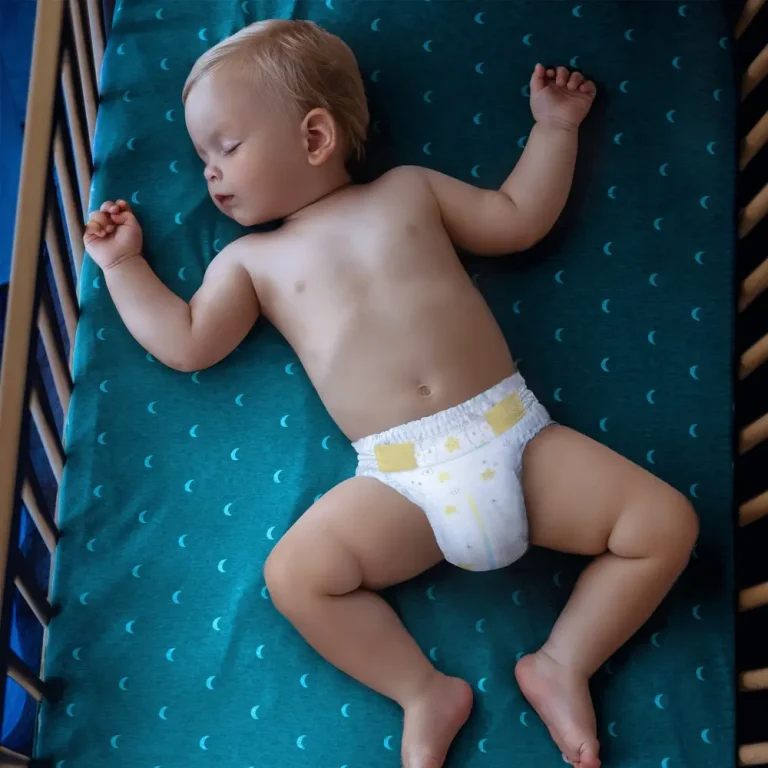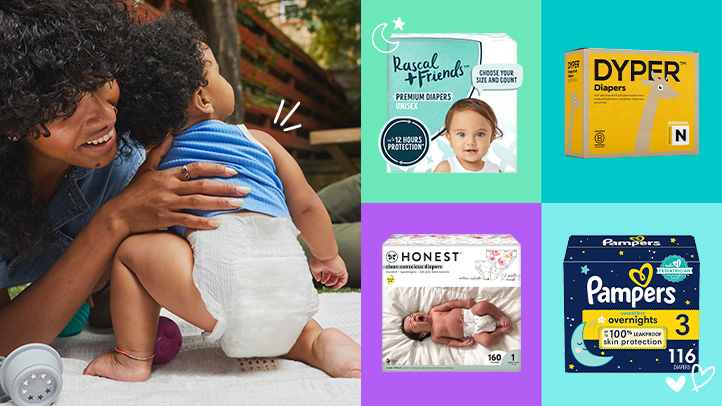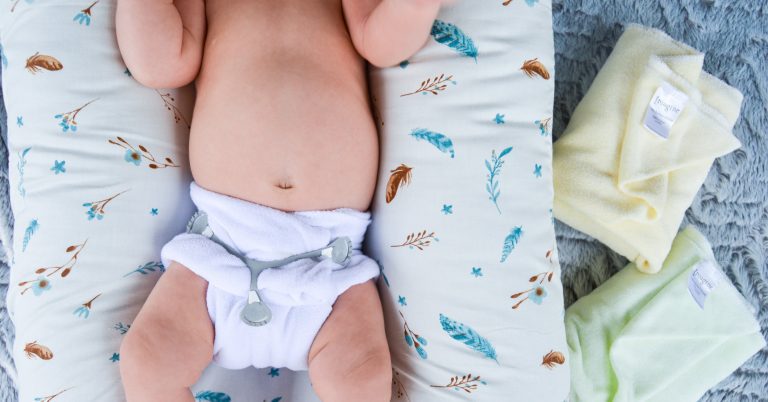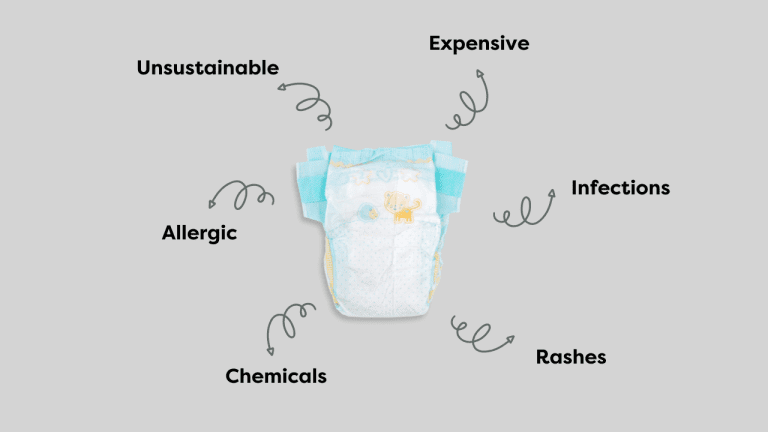How Do Cloth Diapers Work: A Simple Guide for New Parents
Cloth diapers work by using absorbent fabric to contain waste and prevent leaks. They are reusable, eco-friendly alternatives to disposable diapers.
Cloth diapers consist of layers of absorbent fabric, typically cotton, bamboo, or microfiber. They are designed to hold moisture and solids while keeping the baby dry. Parents can fasten them with snaps or Velcro for a snug fit. These diapers come in various styles, including prefolds, fitted, and all-in-one designs.
They require washing after each use, making them a sustainable choice. Many parents prefer cloth diapers for their cost-effectiveness and reduced environmental impact. Additionally, cloth diapers are gentle on a baby’s skin, reducing the risk of diaper rash and irritation.
Introduction To Cloth Diapers
Cloth diapers are a sustainable and cost-effective alternative to disposable diapers. They come in various styles, from prefolds to all-in-ones, making diapering easier. These diapers are made from different fabrics like cotton, bamboo, and hemp. Cloth diapers are reusable and can be washed multiple times, reducing waste. Parents are increasingly choosing cloth diapers for their environmental and health benefits.
Why Choose Cloth Diapers?
Choosing cloth diapers can save families a significant amount of money. On average, disposable diapers can cost thousands of dollars over a baby’s diapering years. Cloth diapers can be reused for multiple children, further increasing savings. They also come in various cute designs, adding fun to diaper changes.
Environmental And Health Benefits
Environmental Benefits:
- Cloth diapers reduce landfill waste.
- They lower the demand for disposable diaper production.
- Using cloth diapers decreases carbon footprint.
Health Benefits:
- Cloth diapers are free from harmful chemicals.
- They reduce the risk of diaper rash.
- Babies in cloth diapers often potty train earlier.
| Benefit | Description |
|---|---|
| Cost Savings | Save money by reusing diapers. |
| Environmental Impact | Less waste and reduced carbon footprint. |
| Health Benefits | Free from chemicals, lower diaper rash risk. |
Types Of Cloth Diapers
Cloth diapers come in various styles. Each type offers unique benefits. Understanding these types helps in choosing the best for your baby. Let’s explore the different kinds.
Prefolds And Flats
Prefolds are rectangular cloths. They have multiple layers of fabric. You fold them to fit your baby. They need a waterproof cover.
Flats are single-layer cloths. They are large squares. You fold them in many ways. They also need a cover.
| Type | Layers | Needs Cover |
|---|---|---|
| Prefolds | Multiple | Yes |
| Flats | Single | Yes |
Fitteds And Contours
Fitteds look like disposable diapers. They have elastic around the legs and waist. They need a waterproof cover.
Contours are shaped to fit the baby. They do not have elastic. They also need a cover.
- Fitteds: Good for heavy wetters.
- Contours: Easier to put on than flats or prefolds.
Pocket Diapers
Pocket diapers have a pocket inside. You stuff inserts into this pocket. The outer layer is waterproof. The inner layer is soft against the baby’s skin.
- Choose your insert material.
- Stuff the insert into the pocket.
- Put the diaper on your baby.
All-in-ones And Hybrids
All-in-One (AIO) diapers are like disposable diapers. They have an absorbent layer and a waterproof outer layer. No need for a cover or stuffing.
Hybrid diapers give you options. You can use a disposable insert or a cloth insert. They have a waterproof shell.
| Type | Features | Convenience |
|---|---|---|
| All-in-One | All parts in one piece | Very convenient |
| Hybrid | Disposable or cloth inserts | Flexible |
Essential Cloth Diaper Accessories
Cloth diapering requires more than just the diapers. Essential accessories make it easier and more efficient. These accessories help in maintaining hygiene and comfort for your baby. Let’s explore the key accessories you need for a smooth cloth diapering experience.
Diaper Covers
Diaper covers are crucial for cloth diapers. They are waterproof layers that go over the cloth diaper. They prevent leaks and keep your baby’s clothes dry. You can reuse diaper covers multiple times before washing them. Choose covers made of breathable materials like PUL or TPU. These materials are gentle on your baby’s skin.
Inserts And Liners
Inserts and liners are absorbent layers placed inside the cloth diaper. They soak up moisture and keep your baby dry. Inserts come in various materials like cotton, bamboo, and microfiber. Each material has different absorption levels. Liners make cleaning easier by catching solids. You can dispose of liners or wash and reuse them.
Wet Bags And Pail Liners
Wet bags and pail liners are essential for storing soiled diapers. Wet bags are portable and waterproof. They are perfect for outings and daycare. Pail liners fit into diaper pails at home. They keep odors and moisture contained. Both wet bags and pail liners are washable and reusable. Choose ones with sturdy zippers or drawstrings for secure closure.
| Accessory | Purpose | Material |
|---|---|---|
| Diaper Covers | Prevent leaks, keep clothes dry | PUL, TPU |
| Inserts | Absorb moisture | Cotton, Bamboo, Microfiber |
| Liners | Catch solids, ease cleaning | Disposable, Reusable |
| Wet Bags | Store soiled diapers on the go | Waterproof fabric |
| Pail Liners | Contain odors and moisture | Waterproof fabric |
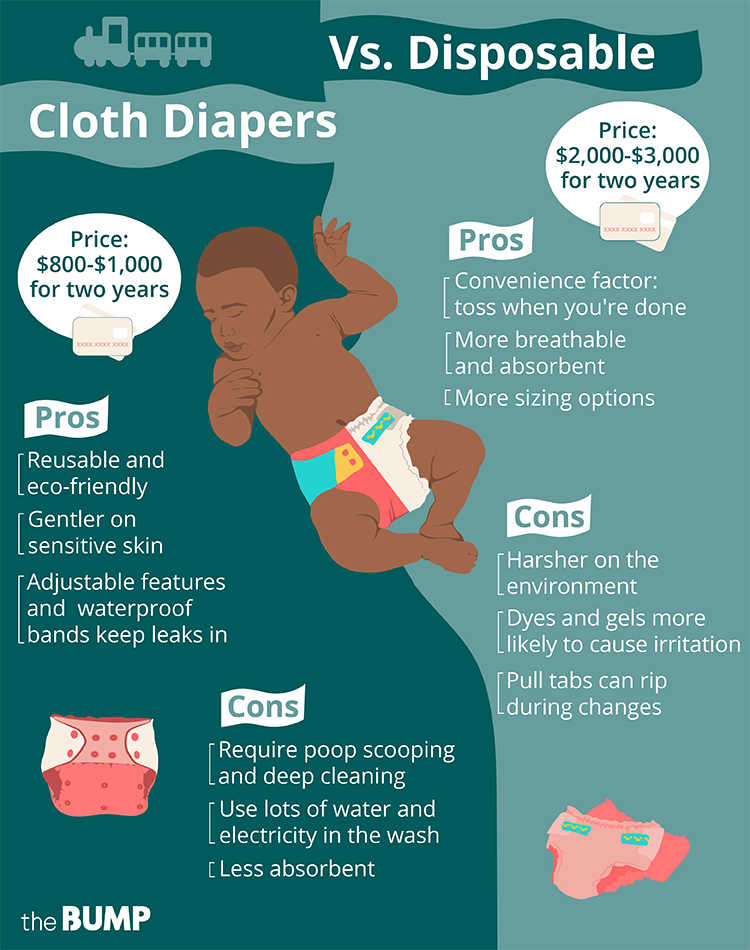
Credit: www.thebump.com
How To Use Cloth Diapers
Cloth diapers are an eco-friendly and cost-effective alternative to disposable diapers. Learning how to use cloth diapers can be simple with a few easy steps. This guide will walk you through preparing, putting on, and changing cloth diapers.
Preparing For First Use
Before using cloth diapers for the first time, they need to be prepped. This involves washing them to remove any residues and enhance absorbency.
- Wash New Diapers: Wash new cloth diapers in hot water with a mild detergent.
- Drying: Dry them completely either in a dryer or on a clothesline.
- Repeat: Repeat washing and drying 2-3 times for maximum absorbency.
Putting On A Cloth Diaper
Putting on a cloth diaper is straightforward and similar to using disposables. Follow these steps to ensure a snug fit.
- Lay Out the Diaper: Lay the diaper flat with the absorbent insert in place.
- Position the Baby: Place your baby on the diaper with the back edge aligned with the waist.
- Secure the Diaper: Pull the front of the diaper up between the baby’s legs and fasten the tabs or snaps at the waist.
- Check the Fit: Ensure the diaper fits snugly around the legs and waist without being too tight.
Changing Cloth Diapers
Changing cloth diapers is as simple as changing disposables. Here’s how to do it efficiently:
- Remove the Diaper: Unfasten the tabs or snaps and remove the soiled diaper.
- Dispose of Waste: Shake solid waste into the toilet and rinse the diaper if needed.
- Store Used Diapers: Place the used diaper in a wet bag or diaper pail until laundry day.
- Clean the Baby: Wipe the baby’s bottom with a cloth wipe or baby wipe.
- Put on a Fresh Diaper: Follow the steps for putting on a cloth diaper with a clean one.
| Step | Action |
|---|---|
| 1 | Wash new cloth diapers |
| 2 | Dry them completely |
| 3 | Repeat wash and dry |
By following these simple steps, you can effectively use cloth diapers for your baby. They are reusable, eco-friendly, and cost-effective. Happy diapering!
Washing And Maintaining Cloth Diapers
Cloth diapers are not only eco-friendly but also cost-effective. Proper washing and maintenance ensure they last longer. Let’s dive into the steps to keep them clean and fresh.
Pre-wash Routine
Start with a pre-wash to remove solid waste. Use a diaper sprayer or dunk in the toilet. Store soiled diapers in a wet bag or pail.
- Rinse diapers in cold water.
- Avoid fabric softeners and bleach.
- Use a baby-friendly detergent.
Main Wash Cycle
After the pre-wash, it’s time for the main wash. This step ensures deep cleaning and sanitization.
- Load the washing machine with diapers.
- Set the wash cycle to hot water.
- Add a suitable amount of detergent.
- Run a long wash cycle.
Drying Methods
Proper drying is crucial to maintain the quality of cloth diapers. Here are some effective drying methods:
| Method | Pros | Cons |
|---|---|---|
| Line Drying | Energy-saving, gentle on fabric | Slower drying time |
| Machine Drying | Faster drying, convenient | Can wear out elastic |
| Indoor Drying Rack | Space-efficient, gentle on fabric | Requires more time |

Credit: alphamom.com
Troubleshooting Common Issues
Cloth diapers are eco-friendly and cost-effective. Yet, users may encounter some challenges. Here, we address common issues and provide simple solutions.
Leaks And Fit Problems
Leaks are a frequent concern. Ensuring the right fit can resolve this.
- Check the size: Diapers should snugly fit around the waist and legs.
- Adjust the rise snaps: Ensure the diaper covers your baby’s bottom completely.
- Use proper inserts: Add extra inserts for heavy wetters, especially at night.
Remember to change diapers frequently. Overly wet diapers can cause leaks.
Stains And Odors
Stains and odors can be bothersome. Follow these tips for a clean diaper.
- Rinse immediately: Rinse soiled diapers in cold water to prevent stains.
- Use a diaper sprayer: This tool helps remove solids before washing.
- Choose the right detergent: Use a cloth diaper-safe detergent to avoid residue.
Sun-drying diapers can naturally bleach and freshen them. The sun’s rays help eliminate bacteria and odors.
Dealing With Diaper Rash
Diaper rash can cause discomfort. Quick action can help ease the rash.
| Step | Action |
|---|---|
| 1 | Change diapers often: Keep your baby’s skin dry. |
| 2 | Use diaper rash cream: Apply a cloth diaper-safe cream. |
| 3 | Air out: Let your baby go diaper-free for short periods. |
Always wash cloth diapers thoroughly to remove any irritants. This helps prevent diaper rash.
Cost And Savings Of Cloth Diapers
Cloth diapers are a great way to save money. They offer long-term savings and can be reused. Many parents find them more economical than disposables. Let’s break down the costs and savings.
Initial Investment
The initial cost of cloth diapers can be high. You need to buy multiple diapers. Expect to spend around $300 to $500 for a full set. This includes covers, inserts, and accessories. Here’s a simple table to illustrate the costs:
| Item | Cost |
|---|---|
| Diaper Covers (12-15) | $150 – $200 |
| Inserts (24-30) | $100 – $150 |
| Accessories | $50 – $100 |
Long-term Savings
Cloth diapers can save you a lot over time. Disposable diapers cost about $70 per month. Over two years, that’s $1,680. Cloth diapers cost much less in the long run. Here’s a comparison:
- Disposable Diapers: $1,680 over two years
- Cloth Diapers: $300 to $500 initial investment
You can save over $1,000 with cloth diapers. They also reduce waste, helping the environment.
Resale Value
Cloth diapers have good resale value. You can sell them after use. Many parents buy used cloth diapers. They look for deals and savings. Selling your cloth diapers can recoup some costs. Here’s how much you can expect:
- Gently Used Diapers: 50% to 75% of the original price
- Heavily Used Diapers: 25% to 50% of the original price
This adds to your savings, making cloth diapers even more economical. By reselling, you contribute to a sustainable cycle.
Tips For Cloth Diapering Success
Cloth diapering can be both economical and eco-friendly. However, it requires some planning and dedication. Here are some tips to help you succeed with cloth diapering.
Building A Routine
Consistency is key for cloth diapering success. Establish a washing routine to keep diapers fresh and clean.
- Pre-wash diapers to remove waste.
- Use a hot water cycle with a gentle detergent.
- Rinse thoroughly to avoid detergent buildup.
- Air dry or tumble dry on low heat.
Keep a dedicated diaper pail for soiled diapers. This helps contain odors and makes washing easier. Wash diapers every 2-3 days to prevent stains and smells.
Traveling With Cloth Diapers
Traveling with cloth diapers requires preparation. Pack enough diapers, wipes, and a wet bag for soiled ones.
- Use a waterproof wet bag to store dirty diapers.
- Bring a few extra diapers to be safe.
- Consider using disposable liners for easier cleanup.
Plan laundry stops if on a long trip. Many laundromats or hotels offer laundry services. This helps keep your diapers clean and ready to use.
Support And Resources
Join online communities and forums for cloth diapering support. These groups offer valuable advice and encouragement.
- Search for local cloth diapering groups on social media.
- Visit websites dedicated to cloth diapering for tips and guides.
- Attend workshops or events related to cloth diapering.
Seek advice from experienced parents. They can provide tips and share their experiences. This helps you feel more confident in your cloth diapering journey.

Credit: nickisdiapers.com
Frequently Asked Questions
What Are Cloth Diapers?
Cloth diapers are reusable diapers made from natural fibers or fabrics. They are eco-friendly and cost-effective. Unlike disposables, they can be washed and reused multiple times.
How Do Cloth Diapers Absorb Moisture?
Cloth diapers use multiple layers of fabric to absorb moisture. Materials like cotton, bamboo, or microfiber are common. They wick moisture away from the baby’s skin, keeping it dry.
Are Cloth Diapers Better For The Environment?
Yes, cloth diapers are better for the environment. They reduce landfill waste and are reusable. Washing them uses water but is less impactful than producing disposables.
How Often Should Cloth Diapers Be Changed?
Cloth diapers should be changed every 2-3 hours. This helps prevent diaper rash and keeps the baby comfortable. Nighttime use may require more absorbent inserts.
Conclusion
Cloth diapers are an eco-friendly and cost-effective option for parents. They are simple to use and maintain. By understanding their benefits and proper usage, you can make an informed decision. Embrace cloth diapers for a sustainable future and a happier baby.
Start today for a healthier tomorrow.


